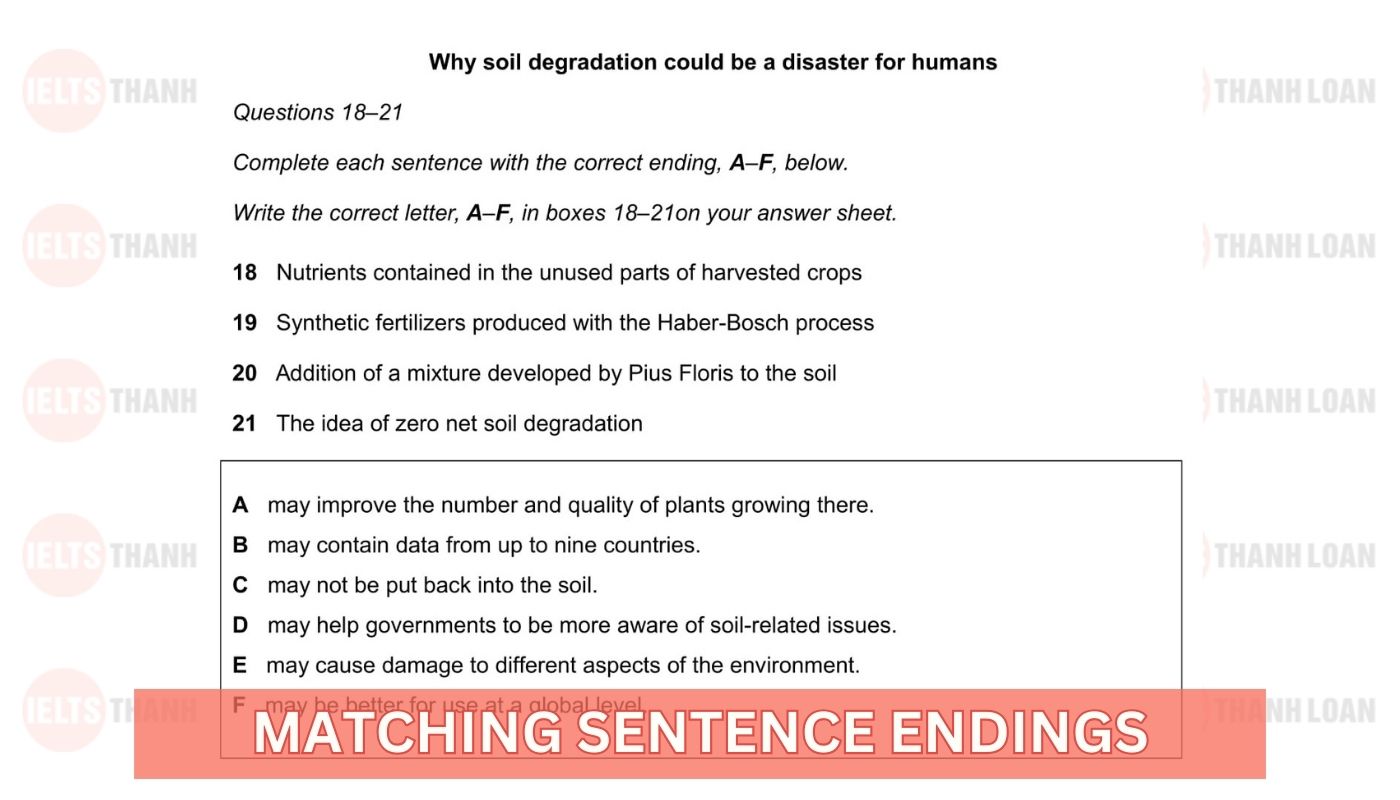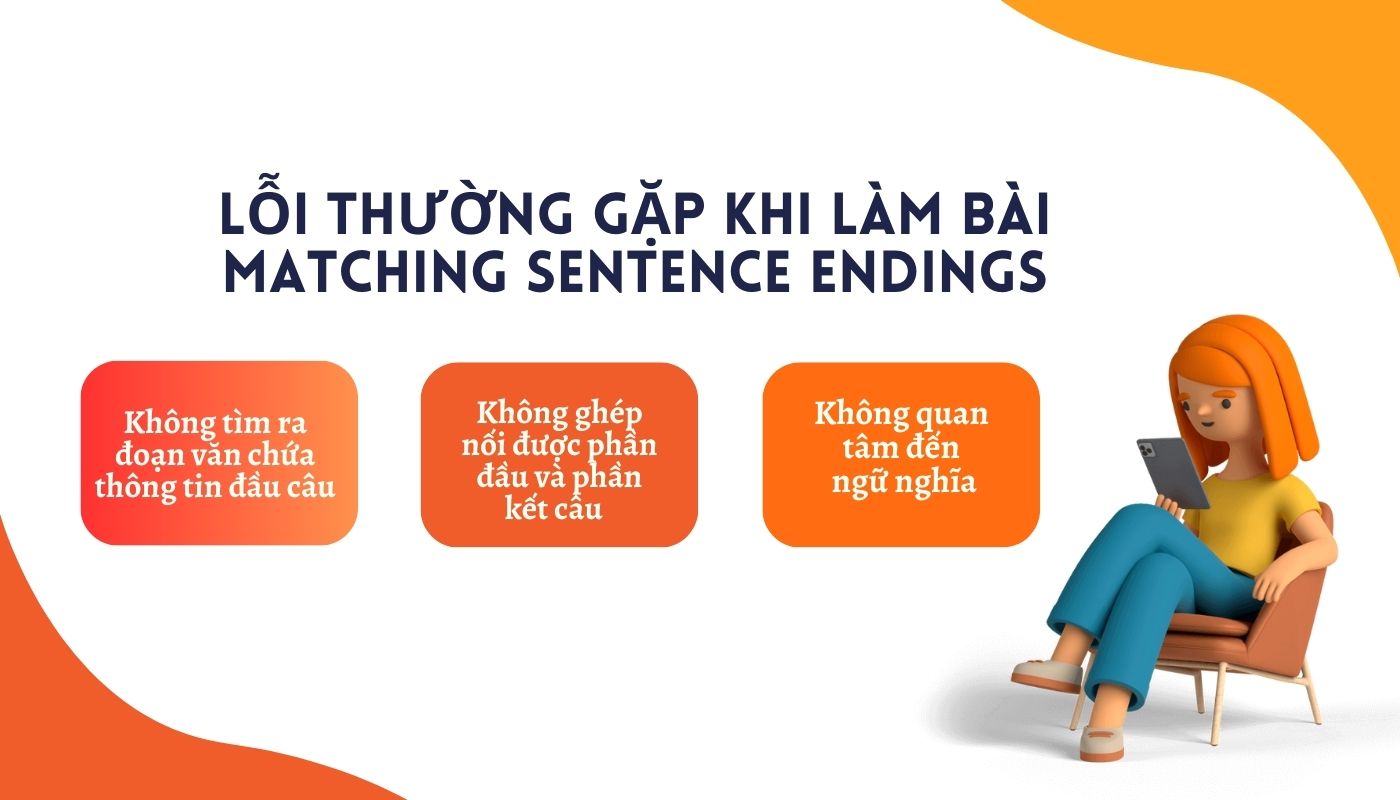Matching Sentence Endings là dạng bài thường xuyên xuất hiện trong phần thi IELTS Reading. Đây là dạng bài kiểm tra khả năng đọc hiểu nội dung, tư duy logic và kỹ năng tìm kiếm thông tin của thí sinh. Để làm tốt phần Matching Sentence Endings IELTS, bạn cần nắm rõ các phương pháp làm bài hiệu quả, Hãy cùng IELTS Thanh Loan tìm hiểu chi tiết cách làm bài Matching Sentence Endings qua bài viết dưới đây nhé!
Matching Sentence Endings là gì?
Reading Matching Sentence Endings là một dạng bài yêu cầu thí sinh nối phần đầu của các câu chưa hoàn chỉnh với phần kết câu phù hợp. Theo đó, đề bài sẽ cung cấp 02 danh sách: một danh sách chứa các câu hỏi chưa hoàn chỉnh (matching endings) và một danh sách khác bao gồm phần đuôi của câu (sentence endings). Nhiệm vụ của thí sinh là dựa vào nội dung của bài đọc để nối các phần đuôi phù hợp, tạo thành một câu văn hoàn chỉnh và có nghĩa.

- Format đề thi IELTS Reading Matching Sentence Endings
Cách làm bài Matching Sentence Endings trong IELTS Reading
Để làm tốt Matching Sentence Endings một trong những dạng bài thi IELTS Reading phổ biến, thí sinh cần vận dụng chiến lược đọc hiểu và phân tích thông tin một cách logic theo các bước sau:
Bước 1: Đọc kỹ tiêu đề chính và tiêu đề phụ
Bước đầu tiên, thí sinh nên dành khoảng 10 – 15 giây để đọc qua tiêu đề chính & tiêu đề phụ của bài Reading. Điều này giúp bạn có cái nhìn tổng quan về nội dung chính của toàn bài và định hướng cách làm bài hiệu quả hơn.
Bước 2: Đọc nửa câu đầu tiên của câu hỏi và xác định từ khóa
Tiếp theo, thí sinh cần đọc kỹ nội dung của nửa câu đầu tiên trong mỗi câu hỏi, và chú ý đến các từ khóa như danh từ, động từ, tính từ, số liệu hoặc địa điểm. Sau đó, gạch chân những từ khóa quan trọng để dễ dàng đối chiếu với phần kết câu (sentence endings).
Ví dụ đề bài Matching Sentence Endings IELTS Sample:

- Đề bài mẫu

- Câu hỏi mẫu Matching Sentence Endings
Từ đề bài và câu hỏi trên, ta có nhận định như sau:
“Question: Employees whose values match those of their employers are more likely to ______”
→ Cần tìm thông tin trong bài đọc đề cập đến sự hoà hợp về giá trị của nhân viên và người làm chủ.
Bước 3: Tìm đoạn chứa thông tin liên quan trong bài đọc
Sau khi xác định từ khóa trong nửa câu đầu tiên, bước tiếp theo, thí sinh cần tìm đoạn chứa thông tin liên quan trọng bài đọc. Để làm điều này, bạn cần chú ý đến 02 loại từ khóa:
- Từ khóa cố định (không thể thay đổi): Đây là những từ khóa dễ nhận biết trong bài, bao gồm tên riêng, tên đất nước, con số hoặc từ vựng chuyên ngành. Các từ khóa này sẽ không bị biến đổi hoặc thay thế trong cách paraphrase, giúp bạn dễ dàng xác định vị trí thông tin.
- Từ khóa có thể thay đổi được: Đây là các từ khóa có khả năng bị paraphrase hoặc diễn đạt lại bằng cách khác, bao gồm các cụm từ, động từ, danh từ hoặc tính từ. Do đó, thí sinh cần vận dụng linh hoạt vốn từ vựng đồng nghĩa & trái nghĩa để xác định từ khóa chính xác.
Dựa vào câu hỏi: “Question: Employees whose values match those of their employers are more likely to ______”.
→ Ta xác định được các từ khóa quan trọng là: “employees”, “values” ,“match” và “employers”.
→ Thông tin tương ứng được đề cập trong đoạn số 2 của bài đọc:
“For Robert B. Cialdini, Professor of Psychology at Arizona State University, one reason that companies don’t succeed as often as they should is that innovation starts with recruitment. Research shows that the fit between an employee’s values and a company’s values makes a difference to what contribution they make and whether, two years after they join, they’re still at the company. Studies at Harvard Business School show that, although some individuals may be more creative than others, almost every individual can be creative in the right circumstances.”
Bước 4: Xem xét các phần đuôi câu và chọn đáp án
Sau khi tìm được đoạn văn chứa thông tin liên quan, thí sinh sẽ tiến hành so sánh nửa đầu câu hỏi (Matching Sentences) với các phần đuôi câu (endings) mà đề bài cung cấp. Để chọn đáp án đúng, bạn cần phân tích từng endings và xem xét sự tương đồng về mặt ý nghĩa và ngữ pháp.
Ví dụ: “Employees whose values match those of their employers are more likely to ______”.
→ So sánh thông tin vừa tìm được trong bài đọc với danh sách Sentence endings mà đề bài cung cấp, ta có:
| Passage | List of endings |
| Nhân viên có giá trị phù hợp với giá trị của người chủ thường có nhiều khả năng _____ |
A. take chances. B. share their ideas. C. become competitive. D. get promotion. E. avoid risk. F. ignore their duties. G remain in their jobs. (đáp án đúng) |
Lỗi thường gặp khi làm bài Matching Sentence Endings

- Những lỗi phổ biến khi làm dạng câu hỏi Matching Sentence Ending
Khi làm dạng bài Matching Sentence Endings, nhiều thí sinh thường mắc các lỗi liên quan đến cách xác định từ khóa, cách ghép nối câu và bỏ qua ngữ nghĩa của nội dung. Ví dụ như:
Không tìm ra đoạn văn chứa thông tin ở phần đầu câu
Lỗi phổ biến nhất khi làm Reading Matching Sentence Endings mà phần lớn thí sinh mắc phải là chỉ tập trung tìm kiếm từ khóa trong nửa đầu câu hỏi. Thực tế, các từ khóa trong bài đọc sẽ được Paraphrase hoặc diễn đạt khác đi, nếu bạn chỉ “chăm chăm” tìm từ khóa mà không chủ ý đến nội dung của toàn bài thì sẽ rất khó để xác định đoạn văn chứa thông tin liên quan.
Không ghép nối được phần đầu và phần kết câu
Ngay cả khi tìm được đoạn văn chứa thông tin liên quan, nhiều thí sinh vẫn gặp khó khăn trong việc ghép nối phần đầu và phần kết của câu. Lỗi này xảy ra do thí sinh không đọc kỹ đoạn văn, khiến việc so sánh giữa câu văn trong bài và phần kết câu (endings) trở nên mơ hồ, dẫn đến việc chọn sai đáp án.
Chỉ dựa vào logic hoặc cấu trúc ngữ pháp mà bỏ qua ngữ nghĩa
Khi làm bài Matching Sentence Endings, thay vì đọc kỹ nội dung đoạn văn, không ít thí sinh chọn đáp án bằng cách suy luận dựa trên cấu trúc ngữ pháp và logic của câu. Đây là cách tiếp cận hoàn toàn sai vì dạng bài này yêu cầu người đọc phải hiểu ngữ nghĩa cụ thể của nội dung, chứ không đơn thuần chỉ dựa vào hình thức ngữ pháp hoặc cấu trúc câu.
Mẹo làm bài Matching Sentence Endings IELTS Reading hiệu quả
Để tránh những lỗi thường gặp và cải thiện kỹ năng làm bài Matching Sentence Endings, bạn có thể áp dụng một số tips làm bài hữu ích dưới đây.
- Thứ tự đáp án: Đáp án trong bài đọc thường được sắp xếp theo thứ tự các câu hỏi. Vì vậy, sau khi tìm ra đáp án cho câu hỏi đầu tiên, bạn có thể lần lượt tìm các câu trả lời kế tiếp. Điều này giúp bạn xác định rõ vị trí thông tin cần tìm.
- Dự đoán phần kết: Trước khi nhìn vào các lựa chọn đáp án, hãy thử dự đoán phần kết của các câu chưa hoàn chỉnh. Điều này giúp bạn định hình câu trả lời và loại trừ các đáp án không phù hợp.
- Lưu ý từ đồng nghĩa và paraphrase: Để làm tốt dạng bài Matching Sentence Endings, thí sinh hãy lưu ý đến các từ đồng nghĩa hoặc cách diễn đạt khác mà người ra đề có thể sử dụng. Khả năng nhận diện từ đồng nghĩa & Paraphrase sẽ giúp bạn hiểu được ý nghĩa gốc của câu hỏi.
- Chỉ đọc câu endings liên quan: Khi làm Reading Matching Sentence Endings, thí sinh không cần đọc hết tất cả các lựa chọn câu endings. Bạn chỉ cần tập trung vào các lựa chọn có khả năng phù hợp với câu chưa hoàn chỉnh.
- Bắt đầu với từ khóa: Để nhanh chóng khoanh vùng đoạn văn cần tìm, bạn hãy dựa và các từ khóa dễ nhận biết như danh từ riêng, số liệu, ngày tháng, thuật ngữ. Sau đó, đối chiếu chúng với nội dung thông tin trong bài đọc.
- Quản lý thời gian: Hãy dành nhiều thời gian hơn cho câu hỏi đầu tiên, vì đây thường là câu khó nhất. Khi tìm được câu trả lời cho câu đầu tiên, những câu sau sẽ dễ dàng hơn do bạn đã loại trừ một số đáp án không phù hợp.
Bài tập Matching Sentence Endings Reading IELTS
Để cải thiện kỹ năng làm bài Matching Sentence Endings trong IELTS Reading, thí sinh có thể tham khảo và thực hành thường xuyên các bài tập vận dụng sau đây:

- Bài tập thực hành IELTS Reading Matching Sentence Endings
Đề bài:
Great Migrations
Animal migration, however it is defined, is far more than just the movement of animals. It can loosely be described as travel that takes place at regular intervals – often in an annual cycle – that may involve many members of a species, and is rewarded only after a long journey. It suggests inherited instinct. The biologist Hugh Dingle has identified five characteristics that apply, in varying degrees and combinations, to all migrations. They are prolonged movements that carry animals outside familiar habitats; they tend to be linear, not zigzaggy; they involve special behaviours concerning preparation (such as overfeeding) and arrival; they demand special allocations of energy. And one more: migrating animals maintain an intense attentiveness to the greater mission, which keeps them undistracted by temptations and undeterred by challenges that would turn other animals aside.
An arctic tern, on its 20,000 km flight from the extreme south of South America to the Arctic circle, will take no notice of a nice smelly herring offered from a bird-watcher’s boat along the way. While local gulls will dive voraciously for such handouts, the tern flies on.
Why? The arctic tern resists distraction because it is driven at that moment by an instinctive sense of something we humans find admirable: larger purpose. In other words, it is determined to reach its destination. The bird senses that it can eat, rest and mate later. Right now it is totally focused on the journey; its undivided intent is arrival.
Reaching some gravelly coastline in the Arctic, upon which other arctic terns have converged, will serve its larger purpose as shaped by evolution: finding a place, a time, and a set of circumstances in which it can successfully hatch and rear offspring.
But migration is a complex issue, and biologists define it differently, depending in part on what sorts of animals they study. Joe! Berger, of the University of Montana, who works on the American pronghorn and other large terrestrial mammals, prefers what he calls a simple, practical definition suited to his beasts: ‘movements from a seasonal home area away to another home area and back again’. Generally the reason for such seasonal back- and-forth movement is to seek resources that aren’t available within a single area year- round.
But daily vertical movements by zooplankton in the ocean – upward by night to seek food, downward by day to escape predators – can also be considered migration. So can the movement of aphids when, having depleted the young leaves on one food plant, their offspring then fly onward to a different host plant, with no one aphid ever returning to where it started.
Dingle is an evolutionary biologist who studies insects. His definition is more intricate than Berger’s, citing those five features that distinguish migration from other forms of movement. They allow for the fact that, for example, aphids will become sensitive to blue light (from the sky) when it’s time for takeoff on their big journey, and sensitive to yellow light (reflected from tender young leaves) when it’s appropriate to land. Birds will fatten themselves with heavy feeding in advance of a long migrational flight. The value of his definition, Dingle argues, is that it focuses attention on what the phenomenon of wildebeest migration shares with the phenomenon of the aphids, and therefore helps guide researchers towards understanding how evolution has produced them all.
Human behaviour, however, is having a detrimental impact on animal migration. The pronghorn, which resembles an antelope, though they are unrelated, is the fastest land mammal of the New World. One population, which spends the summer in the mountainous Grand Teton National Park of the western USA, follows a narrow route from its summer range in the mountains, across a river, and down onto the plains. Here they wait out the frozen months, feeding mainly on sagebrush blown clear of snow. These pronghorn are notable for the invariance of their migration route and the severity of its constriction at three bottlenecks. If they can’t pass through each of the three during their spring migration, they can’t reach their bounty of summer grazing; if they can’t pass through again in autumn, escaping south onto those windblown plains, they are likely to die trying to overwinter in the deep snow. Pronghorn, dependent on distance vision and speed to keep safe from predators, traverse high, open shoulders of land, where they can see and run. At one of the bottlenecks, forested hills rise to form a V, leaving a corridor of open ground only about 150 metres wide, filled with private homes. Increasing development is leading toward a crisis for the pronghorn, threatening to choke off their passageway.
Conservation scientists, along with some biologists and land managers within the USA’s National Park Service and other agencies, are now working to preserve migrational behaviours, not just species and habitats. A National Forest has recognised the path of the pronghorn, much of which passes across its land, as a protected migration corridor. But neither the Forest Service nor the Park Service can control what happens on private land at a bottleneck. And with certain other migrating species, the challenge is complicated further – by vastly greater distances traversed, more jurisdictions, more borders, more dangers along the way. We will require wisdom and resoluteness to ensure that migrating species can continue their journeying a while longer.
Câu hỏi:
|
Complete each sentence with the correct ending, A-G, below. Write the correct letter, A-G. in boxes 19-22 on your answer sheet 19. According to Dingle, migratory routes are likely to 20. To prepare for migration, animals are likely to 21. During migration, animals are unlikely to 22. Arctic terns illustrate migrating animals’ ability to A. be discouraged by difficulties. B. travel on open land where they can look out for predators. C. eat more than they need for immediate purposes. D. be repeated daily. E. ignore distractions. F. be governed by the availability of water. G. follow a straight line. |
Đáp án:
19 – G
20 – C
21 – A
22 – E
Như vậy, bài viết trên đây đã hướng dẫn cơ bản cách làm dạng bài Matching Sentence Endings trong IELTS Reading. Hy vọng với những kiến thức mà IELTS Thanh Loan đã chia sẻ, bạn sẽ hiểu rõ hơn Matching Sentence Endings là gì, cũng như nắm vững cách làm bài Matching Sentence Endings hiệu quả. Nếu bạn đang tìm kiếm một khóa học IELTS chất lượng với lộ trình học tinh gọn, hãy tham khảo ngay các khóa luyện thi IELTS Online tại IELTS Thanh Loan. Với sự hỗ trợ của đội ngũ giảng viên giàu kinh nghiệm, học viên sẽ được nâng cao toàn diện 04 kỹ năng Nghe – Nói – Đọc – Viết và cam kết về điểm số đầu ra.













